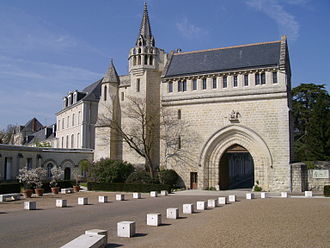The Monastics Arrive
Monasticism is considered to have been "founded" by St Martin of Tours (AD316-397) but one cannot accept this without first paying heed to his own teachers, particularly St Hilary. At the time when St Ninian was about to embark on his "instruction at Rome" three of the great masters or Doctors of the Church - St Ambrose(AD339-397), St Jerome (AD341-420), St Augustine(AD354-430)- were already in their middle ages. Also, in Gaul, St Martin's own master, St Hilary (AD315-368), was only recently dead. As a consequence the leadership of the Gallican Church had devolved on St Martin, abbot-bishop of Caesarodunum, which is Tours.


Above: Entrance to the Monastery at Marmoutier, Tours © Wikipedia

The long connection of Tourraine with Scotland goes back before either Scotland or France existed as discrete kingdoms. The cradle of Scots Christianity is St Martin's Abbey, by the Loire near Tours. The Church in Gaul derived its customs from the East rather than from Italy. Potinus, apostle of Gaul, was a pupil of St Ploycarp of Smyrna, and St Hilary, who consolidated the Church in Gaul, had been for some time in Phrygia. Now, St Martin, a soldier (though probably a conscript) and son of a Roman officer, a great administrator as well as a saint, scholar, and founder of the first Christian hospital in the West, had brought into Gaul an institution new in the Western Church. Long before Christianity arrived, men had withdrawn themselves to solitary contemplation of their God(s). After Christianity came there were Christian hermits too. In the early fourth century St Pachomius had drawn many of these together to live in groups, under a rule of poverty, chastity, and obedience, combining organized prayer with study and manual labour.
St Martin brought this communal, ruled, way of living into the Western Church, in the country of the Pictones - Poitou, Poictou, or Pictavia. On Hilary's return from banishment to Poitiers in 360AD he gave St Martin land at Ligugé where the old soldier then became a solitary monk. However, in time he attracted others and his community became famous, so much so that he was forced to leave this first small house at Ligugé to found another larger one, the Magnum Monasterium, Mór Muinntir or Marmoutier, close to Tours, of which city, as we have said, be became bishop. It was to this community that St Ninian went to study, before coming back to his homeland, and there he became an enthusiastic disciple of St Martin.
St Ninian's foundation at Whithorn was, at first, to be known as Muinntir Mór, but he himself called it after St Martin's first community at Ligugé - Logotegiacum being the Latin form of Ligugé, coming from the Celtic leuk (Gaelic geal, shining white) and tigh, a house. From this then came the name Candida Casa, and its daughter house in Wales Ty Gwynn, the "Bright or Blessed House".
Scotland then was the recipient of Martinian monasticism at a very early time and, very nearly, it could be said to have sprung from the very mouth of its "founder" St Martin. In this sense, we can rightly argue a very ancient pedigree for the Early Church in Scotland and also so also for the Church in Pictland of Alba which was founded from Candida Casa.
The route taken by Ninian on his return to his homeland is a matter of speculation but, I would suggest, it is possible that he came at least in part by sea. The route between the Early Church in Scotland and that in St Martin's Gaul would, certainly until later times, by-pass the church that may have existed in southern and central Britain. Monasticism came first to Scotland and Alba!
small(transp).gif)
